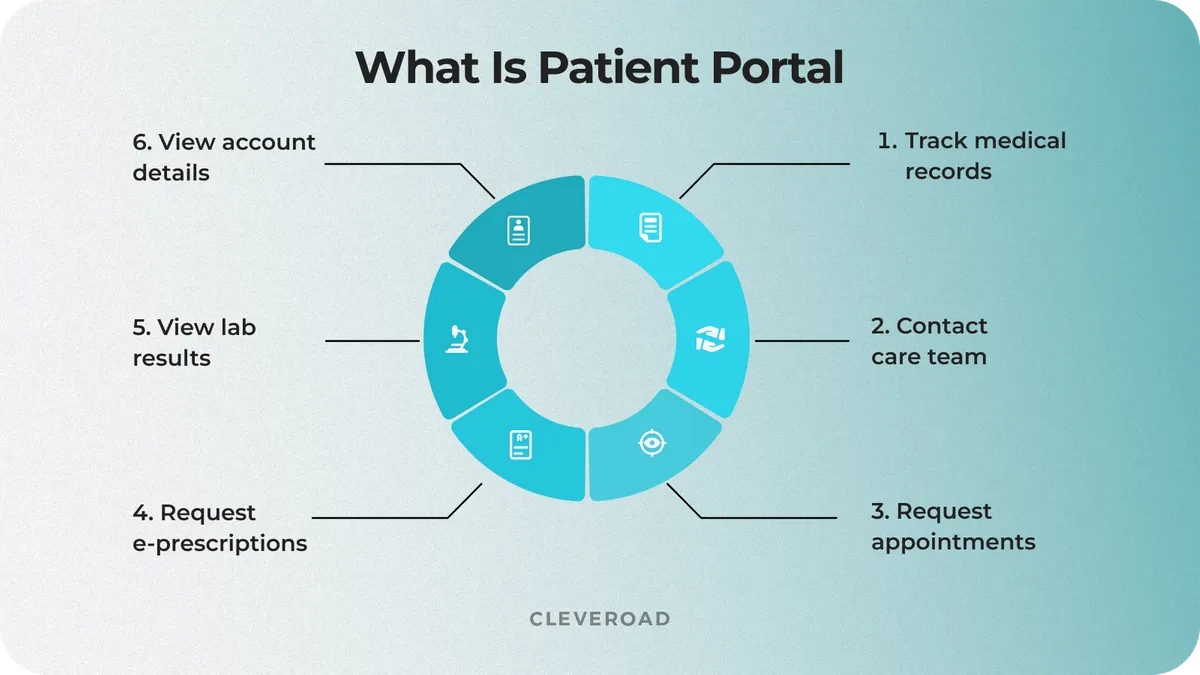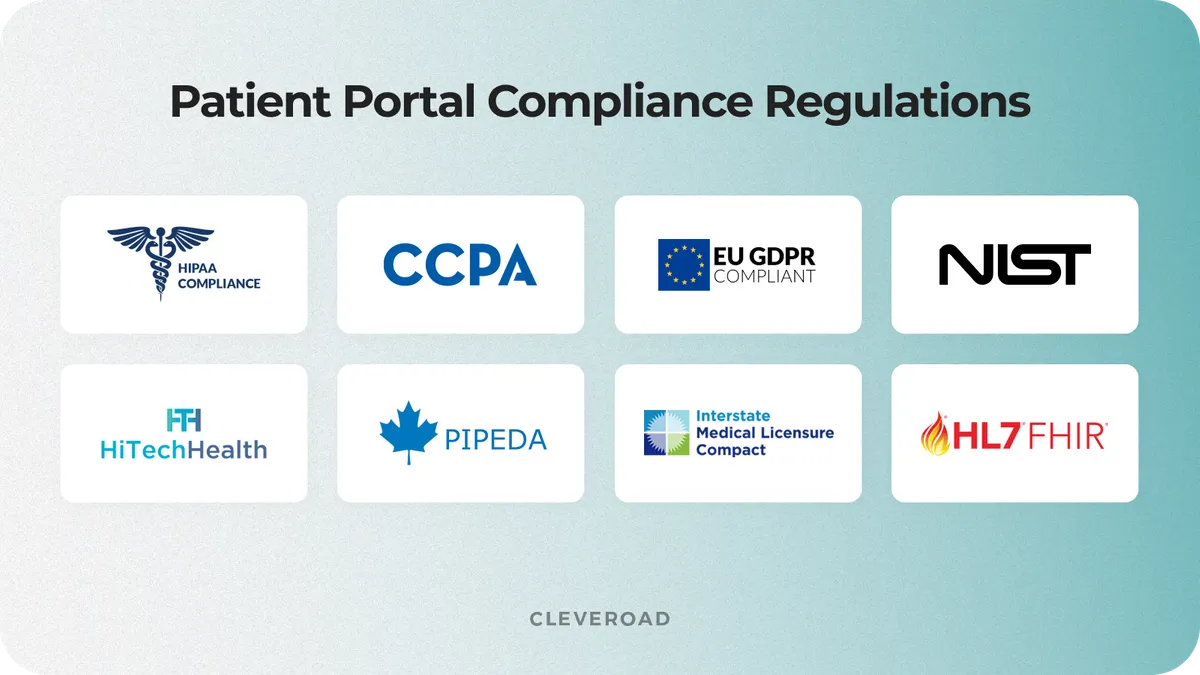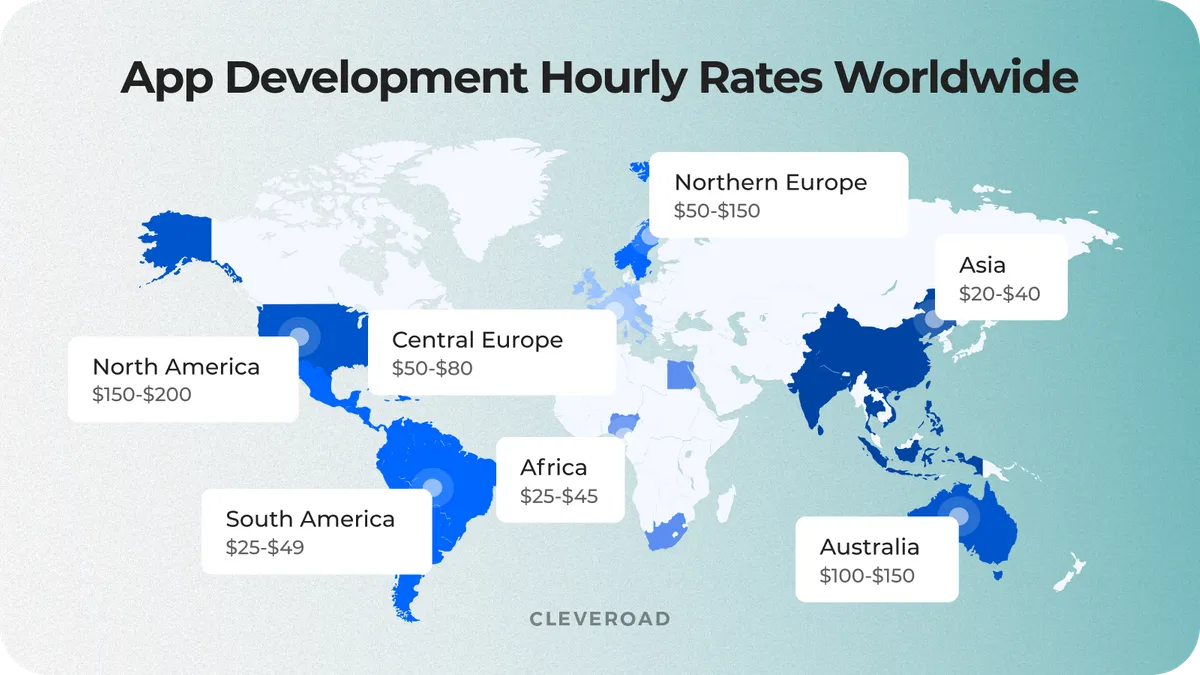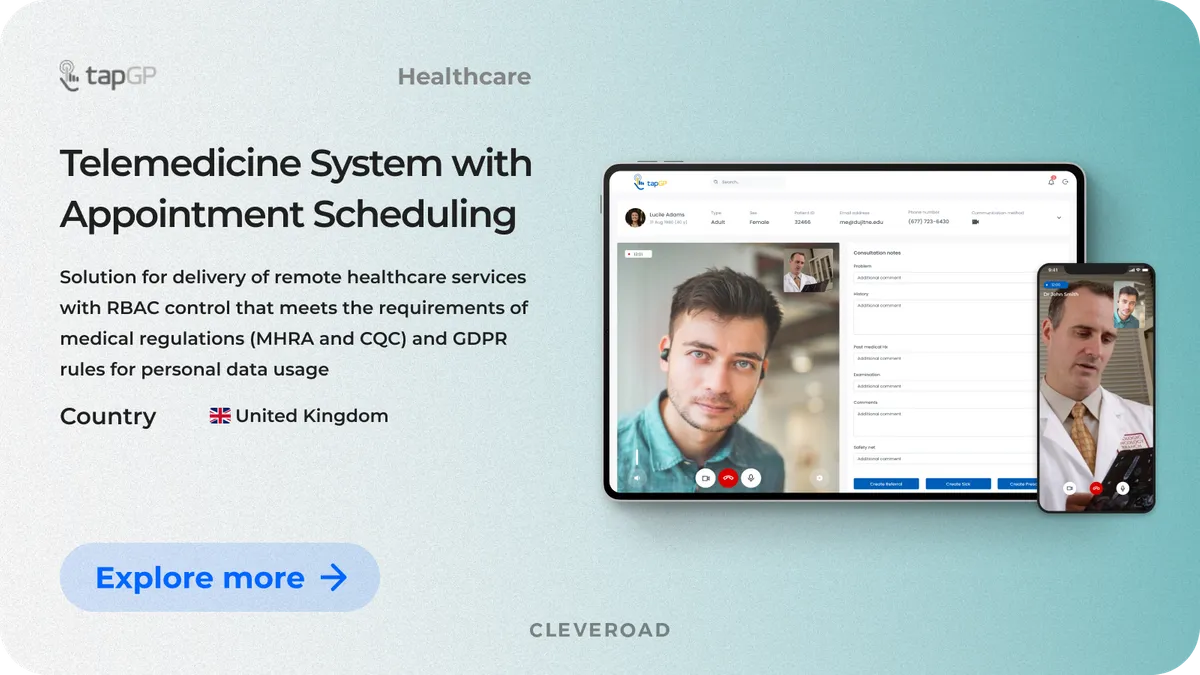Patient Portal Software Development: Complete Guide for 2025
Updated 05 Mar 2025
18 Min
1668 Views
Patient portal development is crucial for healthcare organizations in our customer-centric reality, helping engage your customers thanks to the convenience and speed of medical care. Therefore, companies are looking for secure ways to bridge the gap between patients and care providers while enhancing clinical business metrics. Patient portals enable legal requirement compliances, patient engagement, and satisfaction, and become a win-to-win solution for all the parties involved.
This article reveals the patient portal app development process in detail, its capabilities, must-have functionality, tips to consider, and development cost. So, let’s dive in!
What is the Patient Portal?
A patient portal stands for a web-based and/or mobile solution that provides anytime, anywhere access to health information (e.g., medical records, personal profiles, health billing management, healthcare service history, etc.).
The core goal of patient portal development is to engage patients to look after themselves, increase their health literacy, and bridge the gap between patients and healthcare providers. A patient engagement app enables patients to save time and effort while delivering the same benefits to healthcare institutions.
Paul Brient
Chief Product Officer at athenahealth
Healthcare organizations are moving to try to provide an ideal digital experience for patients. Instead of the digital being secondary, people are creating and making it the primary way in which patients can do everything from schedule, register, and get access to all of their clinical information.
Before you create a custom medical portal software, you should be aware of two main types of patient engagement portals:
- Standalone system
- Integrated service
Let’s consider them in detail.
Standalone patient portal
Standalone medical portals are limited in functionality. Commonly, they focus on one key function, like viewing lab test results or booking appointments. While custom patient portal development, programmers often integrate such solutions with various medical systems (to provide more possibilities), such as:
- Electronic Medical Record (EMR)
- Electronic Health Record (EHR)
- Hospital Management System (HMS)
- Practice management
- Healthcare CRM
- Telemedicine software
- Remote Patient Monitoring solutions, etc.
Due to its price, this portal type is great for small healthcare businesses, like local medical offices or private labs. Based on simpler software architecture and with limited functionality, a standalone patient portal reduces software development costs. However, as the business grows, it can be challenging to scale standalone patient portal up.
Integrated patient portals
Integrated patient portals or tethered portals usually go as a part of an EMR system, an EHR system, or practice management software. Such portal type directly connects to the patient databases of a medical organization and offers a broad range of features and services.
Also, integrated patient portal development demands more time and resources for building and deploying. Thus, it’s associated with higher development costs, which, though, pays off your short- and long-term goals. However, integrated patient portals allow you to provide an affluent patient experience tailored to specific needs.

Main capabilities of patient portals
How Do Patient Portals Affect the Business Processes in Healthcare?
We've discussed what patient portal is and its types. Now, let’s observe the main advantages and opportunities your business will obtain with portal patient development.
Minimized risk for human error
Medical mistakes cost approximately $20 billion a year, the National Center for Biotechnology Information claims. Medical portal software reduces human errors by automating patient data management and other administrative tasks. Medical personnel won’t need to write down the patients’ information or fill in the form numerous times per day. Besides minimizing human factors, patient portal development contributes to optimized medical billing and care payment processing.
Improved performance efficiency
A patient engagement portal can increase the performance efficiency of your healthcare institutions (even for integrated treatment) because it facilitates patient-provider communication. Such platforms accelerate patients’ registration and filling up their details. Furthermore, patient portal development can diminish errors and discrepancies in patient data. As a result, it saves precious time and enhances the quality of your healthcare system.
Better epidemiologic safety
According to a Statista forecast, the global number of users in the digital health market was forecast to continuously increase between 2024 and 2029 by 700 million users (+34.83 percent). Since patients can handle many issues via online portals (e.g., tracking blood pressure), they can stay home, lowering the risk of being exposed. In addition, Healthcare enterprises will have better control of the risk of contagious infection due to reduced foot traffic in clinics and pharmacies. This is particularly helpful for the elderly and little patients.
Enhanced patient care
Long waiting times or difficulty freeing up the time for appointments can be annoying for patients. Patient portal development allows you to address all of these issues by bringing medical care to people remotely. Patient engagement portals cover many medical tasks, from appointment scheduling to getting prescription refills and finding appropriate healthcare professionals. This, in turn, results in reduced maintenance costs (by 94% on average, according to Researchgate research) since there is no need to rent and run administrative facilities and hire personnel.
Explore our robust patient portal development services to see how we can help improve your business with the robust software solution
How to Develop Patient Portal: Step-by-Step Guide
Patient portal development requires a substantial responsibility and a certain amount of preparation because it directly impacts patient health. Therefore, we split the whole process into six steps, and now we will discuss each point in detail.
Step 1. Hiring technical team
First and foremost, you need to contact a software development company competent enough to bring your concept to life and address all the questions that arise. When looking for a tech partner, pay attention to the expertise and experience in healthcare, individual approach, and negotiation flexibility.
For instance, we at Cleveroad, as an experienced healthcare software development company, individually approach each case and build telehealth software solutions that are in tune with the client’s time, budget, and expectations.
Now, we offer you to see what our client from the USA, Daniel Jones, CTA at NURSING, says about cooperation with Cleveroad.
Daniel Jones, CTO at NURSING. Feedback about Cleveroad's Dedicated Development Team Services
Step 2. Requirements analysis
The business analysts and solution architechts scrutinize your patient portal development requirements and business needs and form a project specification. It details all the application’s peculiarities, like features of the patient portal, its technology stack, the number of 3rd party services, etc. A Solution Architect also selects the best-suited web application architecture considering your development platform and non-functional requirements.
These days, DevOps experts suggest paying attention to an advanced architecture based on the cloud-native or microservices patterns. This model works great for evolving a patient portal application with complexities due to its scalability and resilience.
Step 3. UI/UX design and prototyping
The UI/UX designers determine key patient scenarios (e.g., video meeting arrangement, prescription renewal) and visualize the main functionality. Then, they create a prototype of your future app that shows what your software is supposed to do, how it looks, and its capabilities. Finally, designers make appealing user interface elements. Keep your design laconic and intuitive to improve the User Experience (UX). Patients should focus on the core actions, not striving to figure out how to navigate and the patient portal use.
Step 4. Development and integration
This step is the most important and challenging part of patient portal development. During this stage, the team of software developers builds a backend and frontend of your platform as well as a mobile application development (if required). They also integrate necessary APIs, for instance, payment systems that are a must-have for a patient engagement portal. With the patient portal built, it should be integrated with other systems, such as EHR/EMR, CRM systems, hospital department systems, etc. This will allow you to avoid storing fragmented or duplicated data and minimize patient data management costs.
Learn how to make the most of patient portals with CRM software development for healthcare in our full guide
Step 5. Quality assurance and testing
Portal patient development needs quality and testing. A team of technical experts performs multiple manual and automated tests to verify the product’s functional requirements and eliminate the functioning flaws. This stage also aims to assess whether your platform is ready for deployment and complies with core security and regulatory standards.
Step 6. Delivery and maintenance
After undergoing numerous QA tests, the patient portal app is ready to be presented to customers and stakeholders for feedback. Then, based on the collected information, you make improvements if required. It’s worth mentioning that patient portal app development doesn’t finish with the final stage. To keep your product in demand and increase your client base, you should frequently upgrade the functionality (including security and standards compliance monitoring) and support it. These actions will enlarge the software lifecycle, and your app will be able to keep up with the dynamic market and ever-changing user requirements.
Key Features for Custom Patient Portal Development
You should consider the functionality needed for patient portal development. You can create a Minimum Viable Product (MVP) version of an app with basic features only to test if your product will be the popular patient tool. If everything goes well, you can enrich it with more sophisticated features. MVP development services are the best choice when:
- There’s a need to validate the idea
- You’re limited on resources
- You need to reduce the time to market
Patient portals provide secure access to medical records and an easy way to communicate with healthcare practice. Let’s talk about the basic features of such a digital solution that will help you increase patient engagement.
Patient registration
It’s essential to provide an easy and smooth sign-in registration process. Users can be asked to fill out the form to recognize their medical history, previously prescribed medicine, and health reports. This data is saved in the patients’ profiles. Patients can sign in via email, phone, or social media networks. However, personal accounts must be secured, so consider multi-step authentication and/or biometric features (e.g., fingertip recognition).
Personal profiles
A patient portal solution should have a system to handle personal accounts that enable access rights and data protection. In addition, patients should be able to manage their general personal information, including editing and upgrading private data as ordered by HIPAA and other standards.
Patient data management
This feature is vital for patient portal app development. An online patient portal should give access to individual patient data. This feature allows doctors and patients to access specific information, such as users’ EHRs, insurance management, lab test results, billing history, prescription plans, etc.
Appointment scheduling
Patients should be allowed to schedule an appointment with their physicians by viewing the availability of a specific doctor. Once the time slot is selected, the users get the confirmation via email or SMS. A user-friendly interface with clear time slots and reminders helps reduce missed appointments and enhances overall patient satisfaction.
You can also integrate such an application with your portal. Learn more about the doctor appointment app development in our article.
Prescription management
Patient portal development should provide a feature for telemedication. The ongoing treatment and repeated medical care often demand patients access prescription refills. Thus, patients should be able to get drug prescriptions online. Easy access to digital prescriptions ensures patients receive the necessary medications on time, avoiding treatment interruptions.
Learn how e-prescription app development allows for simplified prescription management
Secure encrypted messaging
Besides real-time communication with medical professionals, patients should have secure messaging to get a personalized consultation via protected chat. Developers can implement it via a patient portal live chat feature or AI-powered chatbot that can answer users’ questions based on FAQs. This functionality is valuable for addressing minor issues or chronic disease management.
Online payments
This feature is useful for everyone. Patients can pay for the medical services they’ve used, the platform owner gets a fee, and the physicians can get paid for the service provided. The best way to add online payments is to integrate payment gateways, such as Stripe, PayPal, and Braintree. However, if you want to design a customized patient portal system development service, you must follow the latest data regulations and security protocols. In this case, it’s better to collaborate with a professional software development company that will help you realize the functionality correctly.
Security
Security is vital, primarily if you deal with sensitive data. Integrating data encryption protocols, role-based access authentication, security standards, and other measures will ensure personal data security. In addition, following regulations, such as CMS, HIPAA, Health Level 7 integration, etc., is a must for patient portal app development.
We at Cleveroad, as an ISO 27001-certified company, develop software for healthcare adhering to international standards of security management, which is confirmed by the ISO/IEC 27001:2013 certificate. We maintain high operational efficiency and ensure the security of sensitive information, also strictly adhering to industry compliance regulations we work in.
Appointment summary notes
Patients forget most of the doctors' instructions once they leave the clinic. This makes it difficult for people to comprehend how to follow their treatment plan. That’s why it is better to allow physicians to include summary notes from the appointment in the patients’ accounts. Clear and accessible notes in a patient portal can help customers stay on track with their care, reduce misunderstandings, and improve patient personal health outcomes.
Improved UX
A strong user experience (UX) covers both function and design. That means the patient portal development should provide a good looking and feeling smooth product. Patients should find what they need in the portal without frustration. Always test the UX to confirm everything works well and follows HIPAA rules. Compare it to industry standards and competitors by checking patient portal design quality, navigation, ease of use, speed, and patient feedback.
After providing the basic functions of your patient portal, it’s time to consider the extra patient portal features that expand your product opportunities for its users. There is a list of potential additional functions you can add:
- Educational materials
- Pre-visit form
- Third-party integration
- Linking with social networks
- Remote patient monitoring
Explore more about remote patient monitoring in our comprehensive guide
Tips to Make Your Patient Portal Competitive and Efficient
Before creating your own patient portal, it’s critical to determine the business goals and platform’s features and prepare a clear plan. Remember that your IT partner is here to help you with that. A tech provider analyzes your business strategy and emerging issues to help design and create a patient portal solution addressing your corporate needs.
Follow these steps to get ready for portal patient development.
Identify your target audience
You obviously don't want to appeal to the wrong audience, so researching and determining your buyer persona is essential. The target audience is not just people who use your medical practice management software. It’s a whole market segmented by various factors such as place of residence, age, average income, and much more. Divide your audience starting with basic criteria:
- Gender
- Age
- Average income
- Country of residence
Then get into details by studying their personality, habits, struggles, values, etc. Understanding the target user involves scrutinizing the purpose of your patient portal and what problems it’s solving.
Consider your patients’ priorities
Developing such a portal makes sense when the implemented features align with the users' preferences. Scheduling an appointment with a doctor, viewing test results, and the ability to pay for services are among the most requested patient portal functionalities.
For example, you can use Question and Answer platforms to ask real customers about what they want to see in the patient portal development and what functionality will make their user experience better. Or you can communicate with your social circle directly to gather feedback about their user experience.
Analyze your competitors
It’s always a good idea to look at the competitors to learn from their experiences. What medical portals are your direct competitors? What do they offer? Answering these questions will help you evaluate the uniqueness of your future project and define which way is up. There may be no sense in creating the same product if there is another well-used one. Instead, investing in custom patient portal development will allow you to grab users’ attention and stand out from the competitors.
Study regulatory requirements
Since patient portal development implies personal data processing, your platform must be designed according to specific regulatory and medical standards. These rules were entered to protect sensitive information and prevent cybersecurity risks on time. Here is the list of standards (country-specific) that your medical portal must comply with to be secure and bring value to clients:
- HIPAA regulations (United States)
- Complying with PIPEDA (Canada)
- General Data Protection Directive (Europe)
Depending on geographic location and/or under certain special circumstances, your hospital patient software should also comply with an additional set of laws and regulations, such as CCPA, NIST, HiTECH, IMLC, or FHIR.
If you want to know more details on how to create hospital management system to deal with hospital and patient data and make the created system compliant with leading regulations, you can contact us, and we'll eagerly tell you more!

Patient portal regulations compliance
Consider data security
The healthcare industry is a tidbit for hackers. You must undertake all security measures to protect the patient's data. In addition, there are many telehealth tools, protocols, and algorithms at your disposal.
Here are some critical aspects to consider:
- Maintain compliance. Ensure your patient portal software follows all regulatory standards, which we've discussed above.
- Encryption. Use encryption to prevent data loss from happening. The most popular standards for healthcare portal development are AES 128 Bit and SHA 256.
- Software legacy modernization. Ensure that integrated security software is regularly updated and keeps up with the latest version.
- Patient education. Enhance patients' awareness of all the data security standards. They should be informed of using strong passwords, virus protection, and firewalls wherever applicable on the devices used for medical consultation.
What’s more, you should be PCI DSS certified (Payment Card Industry Data Security Standard) and get an SSL certification (Secure Sockets Layer) to integrate payment functionalities.
Evaluate the portal efficiency
Patient portal app development alone is not enough. You should properly measure its effectiveness using KPIs and comparing data. Monitoring and measuring KPIs is important for business because it reveals whether your current strategy is actually working or not. They’re applied to measure growth and point to the areas of your product that require improvements or alterations.
For instance, with the help of data analysis, you can discover how much time your physicians have saved with the help of a pre-visit form. If you don’t track KPIs, your decisions will be based on hypothesis and personal preference rather than real data. KPIs lead to strategic, data-driven decisions guiding your business in the right direction.
Note: You can get assistance from a competent IT vendor to cover all the preparation steps. The Cleveroad experts (within Discovery services) will undertake all the research you need to plan your telehealth project, including competitor analysis and compliance regulations research.
Patient Portal Software Cost Estimate
Telemedicine software building cost varies depending on platforms, features’ complexity, design, integrations, and software developers’ rates. If you consider all of them, the price to build software solutions for healthcare is approximately $5,500-18,350 per month and $75,000-$250,000+ in total.
Our analysts have calculated the approximate price of patient portal app development on the basic features. The price is based on the average hourly rate of $50 in Central Europe.
| Patient portal's features | Approx time, Flutter (h) | Approx time, Backend (h) | Approx cost ($) |
Features development | 505 hours | 509 hours | $45,630 |
Frameworks and libraries integration | 30 hours | 35 hours | $2,925 |
UI/UX design | 180 hours | 0 | $8,100 |
QA services | 280 hours | 280 hours | $25,200 |
DevOps services | 40 hours | 40 hours | $3,600 |
Project management | 140 hours | 140 hours | $12,600 |
Total | 1,175 hours | 1,044 hours | $98,055 |
Notice: The price above is approximate and includes MVP expenses only. Feel free to contact our Senior Business Analysts to get a custom feature list and project estimate.
It is also worth noting that the final development price is influenced by the location of your technical vendor. We’ve analyzed the rates of software developers in different regions and highlighted the most popular tech hubs. Prices are taken from Clutch, Upwork, and GoodFirms.

Cost to develop patient portals worldwide
Nearshore or offshore software development is a perfect solution if you are looking for a professional team that can drive value at a reasonable price. Here are some advantages of project outsourcing:
- Affordable development costs. Outsourcing vendors provide clients with flexible prices with top-rate services. Furthermore, if you’re looking for a cost-effective solution, Central Europe could be a good solution. The average developer rate here is $50 per hour compared to $150 hourly rates in the US with a similar experience level.
- Access to a pool of talent. Hiring globally lets you attract diverse specialists with a broad set of skills and required expertise. You can hire a dedicated development team by considering different experts from all around the world.
- Enhanced scalability. Going offshore or nearshore, you can quickly scale your team up and down due to project requirements. Besides, the outsourcing approach enables different cooperation models, varying from dedicated team to staff augmentation. Thus, you can select the best efficient solution appropriate for patient portal development.
Cleveroad — Your Partner in Healthcare Software Development
Cleveroad is a skillful healthcare software development company located in Estonia, CEE region. Our team, with 13+ years of experience in delivering medical software solutions, helps established businesses such as hospitals, laboratories, and pharmacies to provide personalized care, reduce operational load, and streamline digital transformation.
Our experts are ready to deliver a wide variety of Healthcare software solutions, such as Hospital Management Software (HMS), medical database and research, appointment scheduling, e-prescribing, and other digital products for Healthcare and Telemedicine. Also, we offer custom-built software with internal systems, such as Patient Portals, EHR, EMR, e-RX services for prescription solutions, and more.
By choosing the cooperation with Cleveroad, you get:
- Three flexible cooperation models: Dedicated Team, IT Staff Augmentation, and Project-Based
- Free Solution Workshop stage to align your healthcare business requirements with technological implementation
- Partnership with an ISO-certified company implementing ISO 9001 quality management systems and ISO 27001 security management standards
- All guarantees for your medical business information security and signing NDA per your request
To illustrate our expertise in practice, let us introduce our latest case — Telemedicine appointments management system. The platform provides 24/7 access to healthcare services, including video and audio consultations.
We’ve successfully delivered a turnkey system compliant with core healthcare regulations (namely MNRA and CQC), including the following modules (but not limited to them):
- Appointment management module. This module allows the administration to view and control the details of each Appointment, including appointments booked for children.
- Patient KYC procedures module. This module enables patients to register in the system by uploading identification documents and taking selfies. We have also added the selfie comparison mode to simplify the verification process.
- Patient’s management module. The module contains detailed and secure patient data and allows patients to schedule/reschedule meetings with doctors and review appointment history.
- Booking system. The booking system helps patients book an appointment with doctors, starting from selecting the needed specialist and ending with confirmation and payment.
- Online meeting functionality. This functionality allows receiving consultation via voice and audio calls. In order to deliver high-quality processing, we’ve integrated a video conferencing API (Twilio).
Boost your telemedicine business
With 13+ years of experience in the Healthcare domain, Cleveroad experts are ready to help you deliver a powerful medical portal that fits your business needs
Building a patient portal involves such steps:
- Step 1. Hiring technical team
- Step 2. Requirements analysis
- Step 3. UI/UX design and prototyping
- Step 4. Development and integration
- Step 5. Quality assurance and testing
- Step 6. Delivery and maintenance
Telemedicine software building cost varies depending on platforms, features’ complexity, design, integrations, and software developers’ rates. If you consider all of them, the price to build software solutions for healthcare is approximately $5,500-18,350 per month and $75,000-$250,000+ in total.
Two main types of patient engagement portals are:
- Standalone system
- Integrated service
The time needed to implement a patient portal depends on many factors, but on average, it can take over 2,250+ hours.

Evgeniy Altynpara is a CTO and member of the Forbes Councils’ community of tech professionals. He is an expert in software development and technological entrepreneurship and has 10+years of experience in digital transformation consulting in Healthcare, FinTech, Supply Chain and Logistics
Give us your impressions about this article
Give us your impressions about this article

